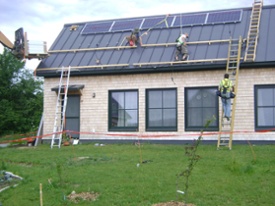
Summer in a High-Performance House
7/30/2014
Summertime in coastal Maine involves warm days, gentle ocean breezes, and lots of blueberries. My family and I are enjoying our first summer in a high-performance house in Belfast Cohousing & Ecovillage, a 36-unit multigenerational community with ultra-energy-efficient homes on 42 acres. The house performed well on windy winter days and during an extended five-day power outage, but now we are seeing how it fares during hot July afternoons without air conditioning.
Despite lots of south-facing windows, our home stays comfortable throughout the day if we close the windows and doors each morning. Considering that my two young children come and go from the house constantly, it isn’t an easy task. Because the summer sun is higher in the sky than in the winter, the southern orientation of the house does not cause it to warm up considerably, and we have curtains to curtail this. The cement slab and lots of insulation help us maintain cool daytime temperatures, even on hot days.
“We really enjoy having lots of fresh air in our home,” explains Hans Hellstrom, a neighbor and member of Belfast Cohousing and Ecovillage. “We open the windows every evening and depending on the weather forecast, close them again mid-morning. Because the homes are so well insulated, we are very comfortable throughout the day.”
During the cool summer nights, we ventilate the home as much as possible – a feat made simpler by our Unilux windows and doors and Zehnder heat recovery ventilation system (HRV). By design, the windows and the kitchen door promote summer comfort. Our triple-pane windows and one of the doors can swing inward on two hinges or be hinged on the bottom and tilted inward to open at the top. This tilted position offers draft-free ventilation and rain protection and boosts safety for small children, thus allowing us to have the windows open when it might otherwise not be a good idea.
The HRV system brings a constant supply of fresh air into the bedrooms and vents stale air out of the bathroom and kitchen. When the windows are open, the system can run in an exhaust-only mode so stale outgoing air is taken from the kitchen and bathroom and exits the home, thus encouraging air movement through the windows.
For optimum summer performance, Aubrey Gewehr, LEED AP, CPHC, Northeast Technical Sales Engineer for Zehnder America, recommends checking the HRV filters in the summer for pollen, which can restrict the flow of intake air. If the filters are covered, they need to be either vacuumed or replaced. In general, filters should be replaced twice a year.
The HRV system is highly efficient in the winter and transfers up to 90 percent of the heat from the outgoing air to the incoming air. This feature is bypassed in the summer under the right conditions to keep the home cooler. If it is too hot outside, the heat exchanger works to cool the incoming air. The HRV system allows the home to be airtight and ultra energy efficient while maintaining high air quality.
Despite living in an all-electric home, our power bills have been very modest due to robust insulation, airtight construction, and a solar orientation. The cement slab is insulated and helps regulate the temperature in the home, providing a cooling effect on hot summer days.
Because we do not have an air conditioner or even fans, our summertime electric use is less than 350-kilowatt hours a month for our 900-square-foot home – including hot water heating and cooking. Our ultra-energy-efficient home uses up to 90 percent less energy for heating than a code-built home would, and our winter energy usage including heating is a mere 800-kilowatt-hour per month.
My husband recently installed a solar system on our home, and thus our monthly electric bills should not be greater than $9.74. Our house is now net zero (consuming as much power as the solar system generates over a 12-month period) with a 3.5-kilowatt solar system. By the end of the summer, 22 of the 36 the ecovillage homes will have solar systems and be near net zero. While the Maine power grid reaches peak demand on hot days when many homes consume large amounts of electricity to run air conditioning units, our solar system produces far more energy than we use in our high-performance house.
——–
Sarah Lozanova is a regular contributor to environmental and energy publications and websites, including Mother Earth Living, Green Building & Design, Triple Pundit, Urban Farm, and Solar Today. Her experience includes work with small-scale solar energy installations and utility-scale wind farms. She earned an MBA in sustainable management from the Presidio Graduate School and she resides in Belfast Cohousing & Ecovillage in Midcoast Maine with her husband and two children.
